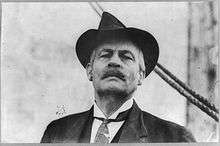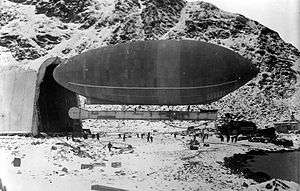Walter Wellman



Walter E. Wellman[1] (November 3, 1858 – January 31, 1934) was an American journalist, explorer, and aëronaut, born at Mentor, Ohio, and educated in the public schools.
Biographical background
Walter Wellman was born in Mentor, Ohio, in 1858.[2] He was the sixth son of Alonzo Wellman and the fourth by his second wife Minerva Sibilla (Graves) Wellman. Walter was a great-great-great-great-great-grandson of Puritan Thomas Wellman. Walter's father, Alonzo, served three years in the American Civil War while Walter was young. He was initially with Company D of the 105th Ohio Infantry before becoming a ship-carpenter with the Mississippi River Squadron. When he returned from the war, he took his family west from Ohio to become pioneer settlers of York County, Nebraska.[3]
At age 14 Walter established a weekly newspaper in Sutton, Nebraska. At age 21 Walter returned to Ohio to establish the Cincinnati Evening Post and married Laura McCann in Canton, Ohio on 24 December 1879. They had five daughters. In 1884 he became political and Washington DC correspondent for the Chicago Herald and Record-Herald.[3]
Early exploration
In 1892 Walter marked with a monument the presumed landing place of Christopher Columbus on San Salvador Island in the Bahamas. In 1894 he led a polar expedition east of Svalbard to latitude 81° N. He led another expedition to latitude 82° N through Franz Josef Land in 1898 and 1899.[3]
Airships
On December 31, 1905, Wellman announced he would make an attempt to reach the North Pole, but this time with an airship.[4] His newspaper provided funds of USD 250,000,[4] and he had an airship built in Paris for the Wellman Chicago Record-Herald Polar Expedition. Wellman established expedition headquarters on Dane's Island, Svalbard, in the summer of 1906.[3] The hangar was not completed until August 1906, and the airship’s engines self-destructed when tested.[5] Wellman rebuilt the airship in Paris that winter and attempted an aerial voyage to the North Pole in September, 1907. He made a second attempt without financial assistance in 1909, but mechanical failures forced him to turn back 60 miles (100 km.) north of Svalbard.[3]
In the northern autumn of 1910, Wellman expanded his airship America to 345,000 cubic feet (9,760 cubic metres) and launched from Atlantic City, New Jersey on 15 October 1910. The engineer Melvin Vaniman sent one of the first aerial radio transmissions when he urged the launch boat to "come and get this goddam cat!" - the cat Kiddo who was (at first) not happy about being airborne.[6][7][8] After 38 hours the engine failed and the airship drifted until they were rescued by the Royal Mail steamship Trent not far from Bermuda.[9][10] A second airship, the Akron, was built the next year. It exploded during its first test flight. Killed were the crew of five, including its captain, the same Melvin Vaniman who was a survivor of the America.[11] Almost a century later its submerged remains were located. These fragments, along with the airship's lifeboat, which Goodyear Tire and Rubber had stored since 1912, were then donated to the Smithsonian Institution.[12]
Legacy
In 1902, Wellman wrote A Tragedy of the Far North published in The White World. Wellman's book The Aerial Age; A Thousand Miles by Airship over the Atlantic Ocean was published in 1911. The German Republic, Imaginary Political History After the European War was published in 1916.[3] He spent his final years in New York City, where he died of liver cancer in 1934. The Liberty ship Walter Wellman was launched 29 September 1944 from Todd Houston Shipbuilding Corporation of Houston, Texas.
References
- ↑ Stevens, George E. (Fall 1969). "From Penny Paper to Post and Times-Star: Mr. Scripps' First Link" (PDF). Cincinnati Historical Society Bulletin. Cincinnati Historical Society. 27 (3): 206–222.
- ↑ Capelotti 1999, page 14
- 1 2 3 4 5 6 Wellman, Joshua Wyman Descendants of Thomas Wellman (1918) Arthur Holbrook Wellman, Boston pp.69-72,407&500-502
- 1 2 Cailliez
- ↑ Capelotti 1999, pages 72-73
- ↑ "Kiddo, the airship cat" Purr'n'Fur
- ↑ "“Roy, come and get this goddamn cat” was the first ever in-flight radio transmission" AviationHumor
- ↑ Copping, Jasper. "America the airship: the first transatlantic crossing" The Daily Telegraph, 13 October 2010. Accessed: 1 November 2014.
- ↑ Trevelyan, Laura (2010-10-15). "Airship America's landmark crossing attempt recalled". BBC News. Retrieved 2010-10-15.
- ↑ Davies, Alan. "Vaniman, the acrobatic photographer". State Library of New South Wales 2007. Archived from the original on 2007-09-04.
enlarged again to 9760 cubic metres volume, giving a lifting capacity of 12 tonnes ... launched on 15 October 1910 ... crew of six, including Wellman and Vaniman and a stowaway cat
- ↑ Dilks, John. What Happened After the Rescue? QST, January 2011, pp. 95-6.
- ↑ 100 Years ago this airship sailed from Atlantic City
- Cailliez, Jean-Claude. Première tentative d’atteindre le Pôle nord en dirigeable : l’expédition W.Wellman (1906-09) 2006-10-12. (French)
- Capelotti, P. J. By Airship to the North Pole: An Archaeology of Human Exploration. 1999. Rutgers University Press. ISBN 0-8135-2633-7
Publications
- P.J. Capelotti, Herman Van Dyk & Jean-Claude Cailliez. 2007. “Strange interlude at Virgohamna, Danskøya, Svalbard, 1906: the merkelig mann, the engineer and the spy,” Polar Research 26 (2007): 64-75.
- P.J. Capelotti. 2006. “E.B. Baldwin and the American-Norwegian discovery and exploration of Graham Bell Island, 1899,” Polar Research 25 (2): 155-171.
- P.J. Capelotti. By Airship to the North Pole: An Archaeology of Human Exploration (Rutgers University Press, 1999) ISBN 0-8135-2633-7
- P.J. Capelotti. 1997. "The Wellman Polar Airship Expeditions at Virgohamna, Danskøya, Svalbard." Oslo, Norway: Norsk Polarinstitutt, Meddelelser No. 145.
- P.J. Capelotti. A Conceptual Model for Aerospace Archaeology: A Case Study from the Wellman Site, Virgohamna, Danskøya, Svalbard. (Ph.D. Dissertation, Rutgers University, 1996). University Microfilms #9633681.
- P.J. Capelotti. 1994. “A Preliminary Archæological Survey of Camp Wellman at Virgohamn, Danskøya, Svalbard,” Polar Record 30 (175).
- Michael Robinson, The Coldest Crucible: Arctic Exploration and American Culture (University of Chicago Press, 2006) ISBN 0-226-72184-1
External links
- Attempt to North Pole by airship (1906) (French)
- Bjørn Fossli Johansen: Virgohamna Norsk Polarinstitutt February 2007 (Norwegian)